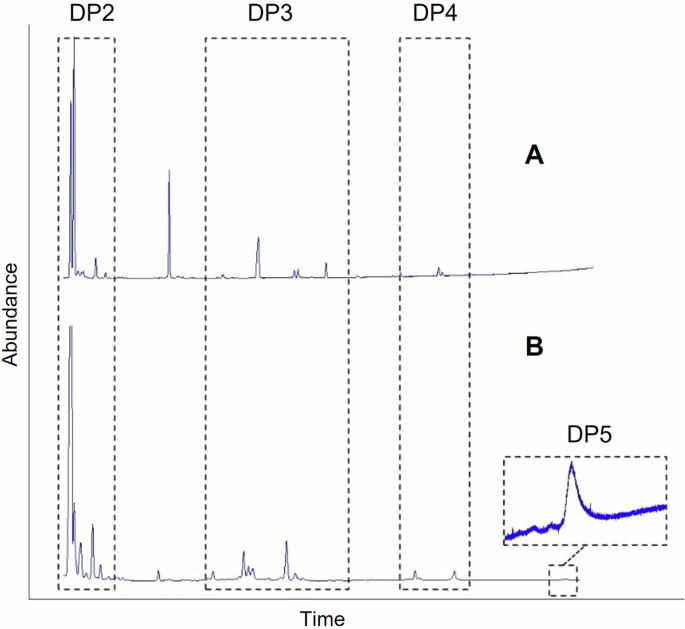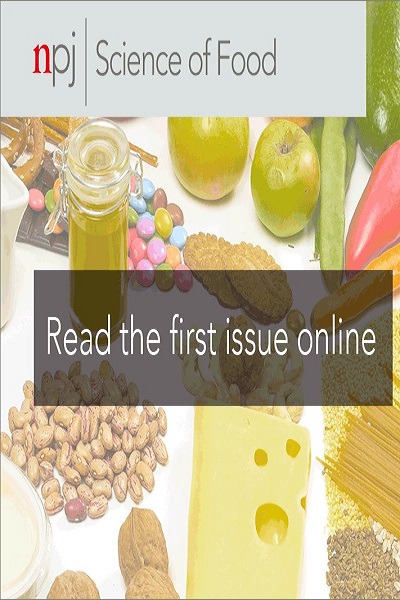定制天然稀有糖 D-塔格糖和 L-山梨糖,以生产新型功能碳水化合物。
IF 6.3
1区 农林科学
Q1 FOOD SCIENCE & TECHNOLOGY
引用次数: 0
摘要
这项多学科研究详细阐述了稀有糖类衍生的新型非消化性低聚糖的生物合成过程,该过程是通过枯草芽孢杆菌 CECT 39(SacB)的左旋蔗糖酶对 D-塔格糖和 L-山梨糖进行转果糖基化实现的。利用核磁共振和分子对接对这些碳水化合物进行表征有助于阐明 SacB 的催化机理和底物偏好。Tagatose 基低聚糖的丰度高于 L-山梨糖基低聚糖,最具代表性的结构是:β-D-Fru-(2→6)-β-D-Fru-(2→1)-D-Tag 和 β-D-Fru-(2→1)-D-Tag。体外研究证明了以标签糖为基础的低聚糖对肠道消化的耐受性及其益生特性,为了解其结构与功能的关系提供了见解。β-D-Fru-(2→1)-D-Tag是三小时后最耐小肠消化的结构(99.8%未发生变化)。这种二糖和商品化的 FOS 聚成相似的分支,表明其对人体粪便微生物群具有相似的调节特性,并且比未改性的塔格糖具有更高的双歧作用。将选定的稀有糖类生物转化为具有更高聚合度的β-果糖基物种,是提高这些碳水化合物的生物利用率并促进其与肠道微生物群相互作用的有效策略。这些发现为定制天然稀有糖类(如 D-塔格糖和 L-山梨糖)提供了新的机会,从而生产出具有功能和结构特性的新型生物合成碳水化合物,可用作新兴的益生元和低热量甜味剂。本文章由计算机程序翻译,如有差异,请以英文原文为准。

Tailoring the natural rare sugars D-tagatose and L-sorbose to produce novel functional carbohydrates
This multidisciplinary study details the biosynthesis of novel non-digestible oligosaccharides derived from rare sugars, achieved through transfructosylation of D-tagatose and L-sorbose by levansucrase from Bacillus subtilis CECT 39 (SacB). The characterization of these carbohydrates using NMR and molecular docking was instrumental in elucidating the catalytic mechanism and substrate preference of SacB. Tagatose-based oligosaccharides were higher in abundance than L-sorbose-based oligosaccharides, with the most representative structures being: β-D-Fru-(2→6)-β-D-Fru-(2→1)-D-Tag and β-D-Fru-(2→1)-D-Tag. In vitro studies demonstrated the resistance of tagatose-based oligosaccharides to intestinal digestion and their prebiotic properties, providing insights into their structure-function relationship. β-D-Fru-(2→1)-D-Tag was the most resistant structure to small-intestinal digestion after three hours (99.8% remained unaltered). This disaccharide and the commercial FOS clustered in similar branches, indicating comparable modulatory properties on human fecal microbiota, and exerted a higher bifidogenic effect than unmodified tagatose. The bioconversion of selected rare sugars into β-fructosylated species with a higher degree of polymerization emerges as an efficient strategy to enhance the bioavailability of these carbohydrates and promote their interaction with the gut microbiota. These findings open up new opportunities for tailoring natural rare sugars, like D-tagatose and L-sorbose, to produce novel biosynthesized carbohydrates with functional and structural properties desirable for use as emerging prebiotics and low-calorie sweeteners.
求助全文
通过发布文献求助,成功后即可免费获取论文全文。
去求助
来源期刊

NPJ Science of Food
FOOD SCIENCE & TECHNOLOGY-
CiteScore
7.50
自引率
1.60%
发文量
53
期刊介绍:
npj Science of Food is an online-only and open access journal publishes high-quality, high-impact papers related to food safety, security, integrated production, processing and packaging, the changes and interactions of food components, and the influence on health and wellness properties of food. The journal will support fundamental studies that advance the science of food beyond the classic focus on processing, thereby addressing basic inquiries around food from the public and industry. It will also support research that might result in innovation of technologies and products that are public-friendly while promoting the United Nations sustainable development goals.
 求助内容:
求助内容: 应助结果提醒方式:
应助结果提醒方式:


